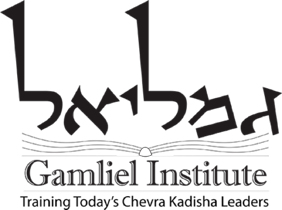Taharah Ritual Details
This page is about the ritual of taharah. For an overview of taharah and shmirah click here. To see a full demonstration of the taharah ritual with an extensive question and answer session, click here.
The details of each step of the taharah ritual are summarized below, however, if more in-depth understanding is desired, students should view the demonstration videos mentioned above, or read about taharah liturgy and then read one or both of the following taharah manuals:
- Chesed Shel Emet, The Truest Act of Kindness, 3rd Edition, by Rabbi Stuart Kelman and Dan Fendel (This manual explains the ideas behind the liturgy in detail.)
- To Midwife A Soul, Guidelines for Performing Taharah, 6th Edition, by Richard A. Light (This manual includes chanting and is specifically organized for ease of use in the taharah room.)
Here is a summary overview of taharah procedures organized into the following five main steps:
- Preparations and opening prayers
- Cleansing the body physically (rechitzah)
- Washing and purifying the deceased spiritually (taharah)
- Dressing the body in the burial garments (halbashah) and placing it in the casket (halanah)
- The closing prayers and debriefing
(1)Preparations and Opening Prayers
Several important events happen during this first phase of the ritual, beginning with the leader checking out the room and the deceased, and then briefing the team on what’s coming. This phase also includes a review by the leader of the procedure with new team members, and assigning roles to specific team members when necessary. The team may set an intention to see the face of G-d in each other as well as the deceased, and then enters the room in silence to begin laying out supplies, donning protective clothing, and preparing the casket. The deceased is covered with a sheet if not already covered, while preparatory readings are recited. These readings include a request for forgiveness from the deceased in case anything amiss should occur; a plea to G-d on behalf of the deceased; and a plea to G-d on behalf of the Chevrah Kadisha members.
(2) Cleansing the Body Physically (rechitzah)
This phase is a sponge bath for the deceased, performed as gently and carefully as one might for a newborn baby. First, any clothing on the body is removed and the body is arranged on the table, naked but covered by a clean sheet. The liturgy opens with a passage from Zechariah. Then, while readings from Song of Songs are recited, the body is completely washed using warm water and soft cloths or batting, fingernails and toenails cleaned and trimmed, and medical devices removed if appropriate and not disrespectful to do so. During all of this washing, the covering sheet remains in place to preserve the modesty and dignity of the deceased; corners are picked up, skin washed under where the sheet was, and then the corner replaced. Some groups rinse the body at this time before covering the body with a new, clean dry sheet. Dirty gloves are removed from team members’ hands and discarded.
(3)Washing and Purifying the Deceased Spiritually (taharah)
Team members’ hands are ritually washed again and clean gloves are donned, and buckets are filled with clean cold water, or in some cases the body is prepared for dunking into a mikvah. This is the spiritual washing phase that is accomplished by simulating the immersion into a running mountain stream (mayim chayim), or dipping the body into a mikvah. Nine kavim (approximately 24 quarts) of water are poured in a continuous stream from head to toe over the deceased, after which a clean dry sheet is placed over the body, and both the body and table are dried thoroughly (being careful not to use towels from the table on the deceased). A special selection of Tanach readings are recited prior to the pouring of water, and during the ritual pouring each member of the team declares three times in Hebrew, Tahor Hu! (He is Pure!) for a man, or T’horah Hi! (She is Pure!) for a woman. Once the body is dried, another clean dry sheet replaces the wet covering.
(4) Dressing the body in the burial garments (halbashah) and placing it in the casket (halanah)
Now the body is dressed in tachrichim, the traditional burial garments designed to be as simple as possible and to resemble the clothes worn by the Kohen Gadol, the High Priest in the days of the Temple. These clothes are made from cotton or linen, have no pockets, buttons, or snaps, and include pants, a shirt, a jacket, a head covering, a belt and leg ties, and sometimes include other things depending on local minhag. The pants have a tie at the waist, the shirt and jacket include a tie at the neck, and there are ties installed on the legs, either just below the knees or at the ankle. Each of these ties is secured with specific knots that represent Hebrew letters included in a name of G-d. As each piece of clothing is installed, a specific phrase from Leviticus is recited that is related to that piece.
Once the deceased is dressed, the aron (casket) is prepared by placing a rectangular sheet-like cloth (sovev) diagonally into the box, with the corners overlapping the sides and ends. If the deceased wore a tallit (prayer shawl) during life, a tallit will be placed into the coffin after removing one of the tzitzit (fringes). The body is then lowered gently into this. The tallit is wrapped around the shoulders, earth from Israel is sprinkled into the casket and on specific areas of the body, and the body is wrapped up in the sovev like a swaddled baby. Some groups also perform other minor rituals during this phase in addition to the recitation of Biblical readings.
(5) The Closing Prayers and Debriefing
Upon completion of the above, the team formally and individually asks the deceased for forgiveness for anything that did not show enough respect during this procedure. The lid is installed and the coffin is ready for burial, often with a lit candle on it. At this point a number of Biblical passages are recited, many of which are related to the protection of the deceased for their upcoming journey.
Once completed, the aron is moved outside of the taharah room, the room is straightened up and gear put away, the team washes their hands again both ritually and with warm water and soap, and the team then assembles in a separate room for the post-taharah debriefing. Here, the emotional health of the team members is supported, as participation in this ritual can be very powerful as well as traumatic at times. In addition, any practical issues that need to be addressed can be discussed outside of the confines of the holy space encapsulating the taharah itself. It is here also that many teams do a closing ritual to separate between this spiritually profound space in which death is a hairbreadth away and the outside mundane world of everyday life.
It should be noted that there is no halachah (formal Jewish law) governing the performance of taharah. Every community has its own local minhag (customs), and it is these local customs that dictate how the ritual is performed in that community. Variations are found between all communities, but the central elements of this ritual remain essentially identical worldwide.
Taharah Education
In the continuum of Jewish death practices, there are many ways to approach taharah education. Here is a short list of the most common topics included in chevrah trainings and community educational events. Other topics can certainly be included as appropriate:
- Spiritual Uplift: stories from the field, how this work has changed the life of so many who have participated
- Emotional Comfort: the impact of taharah on the family and the community
- Understanding taharah liturgy
- Text study related to Jewish death practices
- What is taharah – community, kavanah, tefila and ritual
- Taharah manuals and liturgy – kavanot, prayers, instructions
- Taharah demonstration – procedures, dressing and knot tying
- Handling the emotional aspects of taharah
- Leadership in the taharah room
- Jewish mourning practices
- Managing a chevrah, training the team and educating the community
- Infection control and injury prevention
- Organ, tissue and whole-body donation
- History of the evolution of the Chevrah Kadisha and taharah practices

